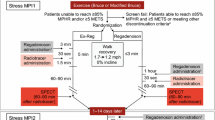Abstract
Background
Although vasodilator stress myocardial perfusion imaging (MPI) is increasingly performed with exercise, adenosine A2A receptor agonists have not been studied with exercise.
Objectives
To determine the safety of administering regadenoson during exercise and, secondarily, to evaluate image quality, patient acceptance, and detection of perfusion defects.
Methods
Patients requiring pharmacologic MPI received a standard adenosine-supine protocol (AdenoSup, n = 60) and were then randomized (2:1) in a double-blind manner to low-level exercise with bolus intravenous injection of regadenoson (RegEx, n = 39) or placebo (PlcEx, n = 21).
Results
Adverse events occurred in 95%, 77%, and 33% of patients receiving AdenoSup, RegEx, and PlcEx, respectively. Peak heart rate was 13 beats per minute (bpm) and 21 bpm greater following RegEx compared to that following PlcEx and AdenoSup, respectively (P = .006 and <.001). Change from baseline in mean systolic blood pressure (SBP), change from baseline to nadir SBP, and percentage of patients with a decline in SBP by ≥20 mm Hg showed no important differences between RegEx and PlcEx. No occurrences of 2nd degree or higher AV block were observed following RegEx or PlcEx; one patient developed 2nd degree AV block following AdenoSup. The mean heart-to-liver and heart-to-gut ratios were improved on RegEx vs AdenoSup: 0.85 (0.34) vs 0.65 (0.26), P < .001 and 1.1 (0.36) vs 0.97 (0.34), P < .001, respectively. Compared to AdenoSup, 70% of patients felt RegEx was much or somewhat better.
Conclusions
Combining regadenoson with low-level exercise is feasible, well tolerated, and associated with fewer side effects compared to AdenoSup.







Similar content being viewed by others
References
Thomas GS, Miyamoto MI. Should simultaneous exercise become the standard for adenosine myocardial perfusion imaging? Am J Cardiol 2004;94:3D-10D; discussion 10D-11D
Thomas GS, Miyamoto MI, Morello AP, 3rd, et al. Technetium 99m sestamibi myocardial perfusion imaging predicts clinical outcome in the community outpatient setting. The Nuclear Utility in the Community (NUC) Study. J Am Coll Cardiol 2004;43:213-23.
Division IMI. Nuclear medicine census market summary reports. Greenbelt, MD; 2006.
Henzlova M, Cerqueria M, Mahmarian J, Yao S. Stress protocols and tracers. In: DePeuy EG, editor. Imaging guidelines for nuclear cardiology procedures: a report from the nuclear cardiology quality assurance committee. American Society of Nuclear Cardiology; 2006. p. 171.
Bedford Laboratories. Full prescribing information for dipyradamole injection. Bedford, OH; 2006.
Astellas Pharma US. Adenoscan (Adenosine Injection) full prescribing information. Deerfield, IL; 2005.
Miller DD. Impact of selective adenosine A2A receptor agonists on cardiac imaging feeling the lightning, waiting on the thunder. J Am Coll Cardiol 2005;46:2076-8
Iskandrian AE, Bateman TM, Belardinelli L, et al. Adenosine versus regadenoson comparative evaluation in myocardial perfusion imaging: Results of the ADVANCE Phase 3 multi-center international trial. J Nucl Cardiol 2007;14:645-58
Fan M, Mustafa SJ. Adenosine-mediated bronchoconstriction and lung inflammation in an allergic mouse model. Pulm Pharmacol Ther 2002;15:147-55
Feoktistov I, Biaggioni I. Adenosine A2b receptors evoke interleukin-8 secretion in human mast cells. An enprofylline-sensitive mechanism with implications for asthma. J Clin Invest 1995;96:1979-86.
Feoktistov I, Biaggioni I. Pharmacological characterization of adenosine A2B receptors: studies in human mast cells co-expressing A2A and A2B adenosine receptor subtypes. Biochem Pharmacol 1998;55:627-33
Shryock JC, Belardinelli L. Adenosine and adenosine receptors in the cardiovascular system: biochemistry, physiology, and pharmacology. Am J Cardiol 1997;79:2-10
Data on File. CV Therapeutics, 2006.
Gao Z, Li Z, Baker SP, et al. Novel short-acting A2A adenosine receptor agonists for coronary vasodilation: inverse relationship between affinity and duration of action of A2A agonists. J Pharmacol Exp Ther 2001;298:209-18
Cerqueira MD, Weissman NJ, Dilsizian V, et al. Standardized myocardial segmentation and nomenclature for tomographic imaging of the heart: a statement for healthcare professionals from the Cardiac Imaging Committee of the Council on Clinical Cardiology of the American Heart Association. Circulation 2002;105:539-42
Updated imaging guidelines for nuclear cardiology procedures, part 1. J Nucl Cardiol 2001;8:G5-58.
Thomas GS, Prill NV, Majmundar H, et al. Treadmill exercise during adenosine infusion is safe, results in fewer adverse reactions, and improves myocardial perfusion image quality. J Nucl Cardiol 2000;7:439-46
Klocke FJ, Baird MG, Lorell BH, et al. ACC/AHA/ASNC guidelines for the clinical use of cardiac radionuclide imaging-executive summary: a report of the American College of Cardiology/American Heart Association Task Force on Practice Guidelines (ACC/AHA/ASNC Committee to Revise the 1995 Guidelines for the Clinical Use of Cardiac Radionuclide Imaging). J Am Coll Cardiol 2003;42:1318–33.
Acknowledgments
The authors would like to acknowledge and thank Raymond Taillefer for his leadership of the nuclear core lab, Kim A. Williams, MD, Diwakar Jain, MD and Ronald G. Schwartz, MD, MS, independent interpreters of the nuclear images at the core lab and Mahesh P. Shah for his contribution of 7 subjects into the trial. We would also like to thank all the study research team and especially the subjects who graciously volunteered to participate in the study.
Drs Thomas, Thompson, Miyamoto, and Ip received research funding from CV Therapeutics. Dr Thomas additionally serves as a consultant to Astellas Pharma and is a past consultant to CV Therapeutics. He receives grant support from General Electric and Molecular Insights Pharmaceuticals and is on the speakers’ bureau for Astellas Pharma. Dr Mathur and Doug Milikien are current and former consultants to CV Therapeutics, respectively, and Dr Lieu is a former employee of CV Therapeutics.
Source of Financial Assistance: CV Therapeutics, Inc.
Author information
Authors and Affiliations
Corresponding author
Additional information
Presented, in part, at American College of Cardiology 56th Annual Scientific Session, New Orleans LA, March 25, 2007.
Rights and permissions
About this article
Cite this article
Thomas, G.S., Thompson, R.C., Miyamoto, M.I. et al. The RegEx trial: a randomized, double-blind, placebo- and active-controlled pilot study combining regadenoson, a selective A2A adenosine agonist, with low-level exercise, in patients undergoing myocardial perfusion imaging. J. Nucl. Cardiol. 16, 63–72 (2009). https://doi.org/10.1007/s12350-008-9001-9
Received:
Revised:
Accepted:
Published:
Issue Date:
DOI: https://doi.org/10.1007/s12350-008-9001-9




